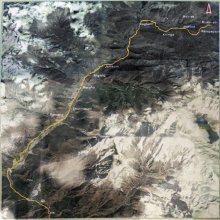Pradarshita, Pradarśita: 9 definitions
Introduction:
Pradarshita means something in Hinduism, Sanskrit, Hindi. If you want to know the exact meaning, history, etymology or English translation of this term then check out the descriptions on this page. Add your comment or reference to a book if you want to contribute to this summary article.
The Sanskrit term Pradarśita can be transliterated into English as Pradarsita or Pradarshita, using the IAST transliteration scheme (?).
Alternative spellings of this word include Pradarshit.
Images (photo gallery)
In Hinduism
Shaktism (Shakta philosophy)
Source: Google Books: ManthanabhairavatantramPradarśita (प्रदर्शित) means “revealed”, according to the commentary on the Ṣaṭsāhasrasaṃhitā, an expansion of the Kubjikāmatatantra: the earliest popular and most authoritative Tantra of the Kubjikā cult.—Accordingly, “The division of these primary and secondary sacred fields, meeting places, weapons, goddesses, guardians, and trees has (also) all been revealed [i.e., pradarśita] in (the teaching concerning) the Wheel of the Skyfarers (khecarīcakra)”.

Shakta (शाक्त, śākta) or Shaktism (śāktism) represents a tradition of Hinduism where the Goddess (Devi) is revered and worshipped. Shakta literature includes a range of scriptures, including various Agamas and Tantras, although its roots may be traced back to the Vedas.
Sports, Arts and Entertainment (wordly enjoyments)
Source: archive.org: Syainika Sastra of Rudradeva with English Translation (art)Pradarśita (प्रदर्शित) refers to “that (quality) which is highly spoken of”, according to the Śyainika-śāstra: a Sanskrit treatise dealing with the divisions and benefits of Hunting and Hawking, written by Rājā Rudradeva (or Candradeva) in possibly the 13th century.—Accordingly, [while discussing the importance of hawks]: “[...] To possess the knowledge of what is practicable and of the means to achieve it, to discern what is easily attainable and what is not, to employ proper persons for proper works and dissuade them from doing what is improper, and such other qualities, which have been highly spoken of (pradarśita) in politics [are considered also essential in the art of hawking]”.

This section covers the skills and profiencies of the Kalas (“performing arts”) and Shastras (“sciences”) involving ancient Indian traditions of sports, games, arts, entertainment, love-making and other means of wordly enjoyments. Traditionally these topics were dealt with in Sanskrit treatises explaing the philosophy and the justification of enjoying the pleasures of the senses.
Languages of India and abroad
Sanskrit dictionary
Source: DDSA: The practical Sanskrit-English dictionaryPradarśita (प्रदर्शित).—p. p.
1) Shown forth, exhibited, manifested, evinced, displayed.
2) Made known.
3) Taught.
4) Explained, declared.
5) Foretold.
Source: Cologne Digital Sanskrit Dictionaries: Shabda-Sagara Sanskrit-English DictionaryPradarśita (प्रदर्शित).—mfn.
(-taḥ-tā-taṃ) 1. Mentioned, specified. 2. Shewn. 3. Prophesied. 4. Taught. E. pra before, dṛś to see, and kta aff.
Source: Cologne Digital Sanskrit Dictionaries: Monier-Williams Sanskrit-English Dictionary1) Pradarśita (प्रदर्शित):—[=pra-darśita] [from pra-darśa > pra-dṛś] mfn. shown, pointed out, indicated
2) [v.s. ...] taught, mentioned, specified, [Manu-smṛti; Mahābhārata] etc.
3) [v.s. ...] prophesied, [Horace H. Wilson]
Source: Cologne Digital Sanskrit Dictionaries: Yates Sanskrit-English DictionaryPradarśita (प्रदर्शित):—[pra-darśita] (taḥ-tā-taṃ) p. Mentioned, shewn, prophesied.
Source: DDSA: Paia-sadda-mahannavo; a comprehensive Prakrit Hindi dictionary (S)Pradarśita (प्रदर्शित) in the Sanskrit language is related to the Prakrit words: Padaṃsia, Payaṃsia.
Sanskrit, also spelled संस्कृतम् (saṃskṛtam), is an ancient language of India commonly seen as the grandmother of the Indo-European language family (even English!). Closely allied with Prakrit and Pali, Sanskrit is more exhaustive in both grammar and terms and has the most extensive collection of literature in the world, greatly surpassing its sister-languages Greek and Latin.
Hindi dictionary
Source: DDSA: A practical Hindi-English dictionaryPradarśita (प्रदर्शित) [Also spelled pradarshit]:—(a) showed; exhibited, displayed; performed; demonstrated.
...
Kannada-English dictionary
Source: Alar: Kannada-English corpusPradarśita (ಪ್ರದರ್ಶಿತ):—
1) [adjective] shown; exhibited.
2) [adjective] prophesied; foretold.
--- OR ---
Pradarśita (ಪ್ರದರ್ಶಿತ):—[noun] that which is exhibited (publicly).
Kannada is a Dravidian language (as opposed to the Indo-European language family) mainly spoken in the southwestern region of India.
See also (Relevant definitions)
Partial matches: Darshita, Pra.
Ends with: Anupradarshita, Apradarshita, Purahpradarshita, Sampradarshita.
Full-text: Anupradarshita, Padamsia, Payamsia, Sampradarshita, Paripurana, Pradarshit, Pradeshamatra, Vilobhana, Akupara.
Relevant text
Search found 10 books and stories containing Pradarshita, Pra-darshita, Pra-darśita, Pra-darsita, Pradarśita, Pradarsita; (plurals include: Pradarshitas, darshitas, darśitas, darsitas, Pradarśitas, Pradarsitas). You can also click to the full overview containing English textual excerpts. Below are direct links for the most relevant articles:
Garga Samhita (English) (by Danavir Goswami)
Verse 2.15.16 < [Chapter 15 - Description of Śrī Rādhā-Kṛṣṇa’s Falling in Love]
Verse 5.20.16 < [Chapter 20 - The Liberation of Ṛbhu Muni During the Rāsa-dance Festival]
Verse 2.1.45 < [Chapter 1 - Description of the Entrance in Vṛndāvana]
Vakyapadiya of Bhartrihari (by K. A. Subramania Iyer)
Verse 3.7.48 < [Book 3 - Pada-kāṇḍa (7): Sādhana-samuddeśa (On the Means)]
Verse 2.210 < [Book 2 - Vākya-kāṇḍa]
Brihad Bhagavatamrita (commentary) (by Śrī Śrīmad Bhaktivedānta Nārāyana Gosvāmī Mahārāja)
Verse 2.2.222 < [Chapter 2 - Jñāna (knowledge)]
Verse 1.4.90-91 < [Chapter 4 - Bhakta (the devotee)]
Sahitya-kaumudi by Baladeva Vidyabhushana (by Gaurapada Dāsa)
Text 8.1 < [Chapter 8 - Literary Qualities]
Manasara (English translation) (by Prasanna Kumar Acharya)
Vasudevavijaya of Vasudeva (Study) (by Sajitha. A)
Vṛttaratnāvalī of Ilattūr Rāmasvāmiśāstri < [Chapter 1 - Śāstrakāvyas—A Brief Survey]
